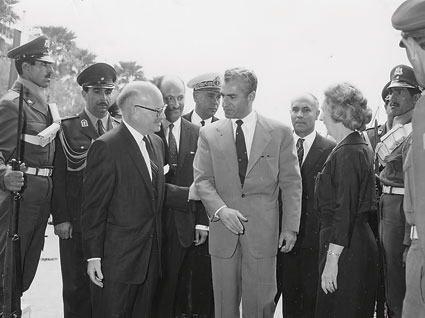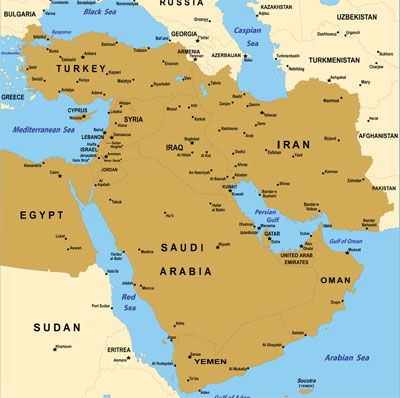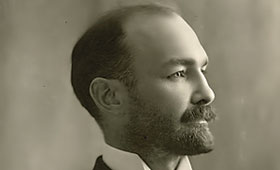
Mar 18, 2013
Exploring Turkey
The Anatolian Peninsula has seen the rise and fall of many civilizations. Students in a January interim course studied the Hellenic, Byzantine, Ottoman…

Students peruse original letters from 1925 for clues about an American’s perspective on education and religion in Iran in a course taught by Prof. Rachel Goshgarian (center).
by Geoff Gehman ’80 | photography by Chuck Zovko
 Exploring a century of political and cultural interactions between the United States and the Middle East—a large, culturally, linguistically, and politically diverse region—opens a lens on a part of the world that seems to continually face unrest and conflict.
Exploring a century of political and cultural interactions between the United States and the Middle East—a large, culturally, linguistically, and politically diverse region—opens a lens on a part of the world that seems to continually face unrest and conflict.
To gain insight into that dynamic region, students in the course The Middle East in the Mind of America and America in the Mind of the Middle East are studying the ways in which individuals, institutions, and administrations in the United States and the Middle East have viewed and imagined one another.
They are examining academic articles, press, speeches, literature, personal histories, and the visual arts, says Rachel Goshgarian, assistant professor of history. One key resource is the Walter A. and Estelle Crawford Groves Papers (1925-30), housed in the College’s Special Collections.
In 1925, Walter A. Groves ’19 was hired as dean of the American School of Tehran by Rev. Samuel Martin Jordan, Class of 1895, who became principal of the boys’ school in 1898. It was run by the Presbyterian Church in the U.S.A., a Lafayette partner. Jordan expanded the school to 12 grades and increased the size of the campus.
A number of Lafayette graduates went there to teach with support from the Lafayette in Persia program on campus. Like Jordan, Groves was fit physically (he swam daily) and culturally (he spoke fl uent Persian). He made sure his son, Warren O. Groves ’48, also spoke proper Persian.
Understanding the importance of his father’s work there, Warren donated the Groves Papers to the College three years ago. The papers provide insight into missionary life in the Middle East in the early 20th century, and American perceptions of the Iranian political state and educational system during the coming to power of Reza Shah Pahlavi.
The papers are an important resource as the College continues to expand and enhance its offerings in global studies. Sarah Shuster ’12, a government & law and philosophy graduate, worked with Diane Shaw, College archivist and director of special collections, to create a website presenting the papers. Shuster is currently a research associate with the Fix the Debt campaign of the New America Foundation, Washington, D.C.
As the students read through these primary sources, they were able to discern for themselves how the idealized view that the Groves’ held of the Middle East changed once they were immersed in the reality, says Goshgarian.
By 1929 the school had a three-year B.A. program and was known as the American College of Tehran. Nearly 900 students could access Iran’s first science building with advanced labs and the country’s best-stocked academic library. These innovations suited the modernization/nationalization campaign of Iran’s monarchy-led government, which in 1932 changed the school’s name to Alborz College.

Lafayette’s second educational connection with Iran occurred nearly 60 years later and 400 miles away.
“I got off the plane in mid-September 54 years ago. I thought I had walked in front of a glass furnace. Abadan is at the head of the Persian Gulf, and it’s very hot in the summer, temperatures of 115 degrees are typical. It was about midnight when we landed.”
And that’s how William A. “Bill” Kirby Jr. ’59 began his adventure in the Middle East, arriving as a recent Lafayette graduate to teach English at Abadan Institute of Technology on a two-year commitment. The experience was transformative—both personally and professionally.
“I had gone there to raise money for graduate school in journalism, but after all of the interfacing with the students, the cultural clashes, I became fascinated and wanted to go back. So I applied to graduate schools where I could study the Middle East.” Kirby completed his master’s at Harvard’s Center for Middle Eastern Studies, served as an intelligence analyst in the Army, then embarked on a career as a foreign service officer for the State Department in the Middle East. “My interest in Iran evolved into an interest in the Arab–Israeli conflict.” Under President Jimmy Carter, he was involved in preparations for the Camp David meetings when Begin and Sadat had their breakthrough, and the negotiations when “that skeleton agreement got fleshed out and became a peace treaty between Egypt and Israel.”
Kirby was among a dozen alumni and faculty members who taught at Abadan Institute of Technology from 1956 to 1967. Faculty and students formed a close-knit community that has remained in touch through the years, including a recent celebration of the 50th anniversary of the Institute’s first graduating class. The three-day reunion, held in Las Vegas, attracted six former American teachers and 31 former Iranian students, including 13 of the 39 graduates and seven dropouts from 1962. Most came from the U.S.; three came from Iran with visas arranged by Kirby.
These schools connected Lafayette and Iran from 1898 to 1940 and from 1956 to 1967. Lafayette graduates modernized educational programs during two pivotal periods in modern Iranian history. They improved diplomatic relations between Iran and the United States, which today are anything but allies. In short, they practiced global citizenship long before the concept was even preached.
Alborz’s reputation was strengthened by graduates who revolutionized their fields. Ali-Asgar Hekmat, a 1918 alumnus, helped open Tehran University as Iran’s minister of education. A 1940 alumna, Sattareh Farman Farmaian, helped develop social work as an Iranian profession.
Farmaian was a member of the last graduating class supervised by Jordan and Groves. In 1940 the Iranian government took control of Alborz and other foreign-run schools. Groves returned to the U.S., where he taught at a college and a seminary in Kentucky. Jordan returned to Iran in 1944 at the request of the U.S. government to support the country’s occupation by Americans, Soviets, and British. He died in California in 1952, the year before Iran’s shah was restored to power after a CIA-assisted coup. Iranian officials honored his educational legacy by putting his name on a Tehran boulevard.

Walter Groves ’19 (left) and Emily Groves welcomed Mohammad Reza Shah Pahlavi during his visit to the college. He was Shah from 1941 to 1979. Courtesy of Ray Jacoby ’57.
In 1956, a consortium of Iranian Oil Exploration and Producing Companies, incorporated in England and acting in an advisory capacity for the nationalized Iranian Oil Company, approached the College to make a survey of the Abadan Technical Institute, according to Albert W. Gendebien ’34, The Biography of a College: A History of Lafayette College 1927-78. The school, located more than 400 miles southwest of Tehran near the Iraq border, had been founded in 1935 by the Anglo–Iranian Oil Company to train local technicians. The survey was conducted to determine how the institute could best meet the needs of Iran’s oil industry.
President Ralph Cooper Hutchison ’18, who had been dean and professor at Alborz from 1925 to 1931, sent a team in summer 1956 to do the study. They recommended that the Abadan College of Engineering be developed. Hutchison became Abadan’s chancellor and hired his former Alborz colleague, Groves, as president. Groves was one of Hutchison’s best friends; in fact, it was Hutchison who introduced Groves to his future wife.
Groves and Hutchison helped develop Abadan’s six-year general-engineering program. Lafayette graduates taught everything from biology to public speaking, engineering graphics to social psychology. Because students came from all parts of Iran, they were housed in dormitories, and extracurricular activities were provided as part of their overall education. The male students, who ranged in age from 17 to 20, were admitted based on entrance exams. The main mission was to train technicians to run Iran’s oil industry. The industry revolved around the Abadan refinery, one of the world’s biggest, newly managed by the U.S. and other world powers.
In 1957 Hutchison lost his College Hill power. He was forced to resign as president by the trustees, who stated that they had not been kept informed and had not approved steps taken to involve Lafayette in the management of Abadan. The announcement was made on the graduation day of Raymond “Ray” B. Jacoby ’57, Hutchison’s former chauffeur and Groves’ future employee.
Jacoby, a history and English graduate, says he accepted the Abadan assignment as a kind of Peace Corps adventure—four years before the birth of the American volunteer brigade. In Iran he quickly became a one-man Peace Corps. He taught world history, current events, and health. He headed the student council, athletic department, and basketball team. As emergency equipment manager, he supplied old Lafayette uniforms with numbers stitched by his wife, Muriel. Unhappy with basketballs that thudded every fourth bounce, he flew to Kuwait to smuggle in balls that bounced right.
Jacoby must have done something right, because in 1960 his Abadan team won the province championship. When his first child was born, his Iranian colleagues celebrated with a chocolate cake topped by a chocolate oil derrick. The gesture typifi ed what he calls “Iran’s built-in gene for hospitality.”
Jacoby received extreme hospitality from Groves and his wife, Estelle. He shared their Thanksgiving dinner and shared their house for three months while he recovered from encephalitis. He repaid their kindness by giving his first child the middle name of Groves. That child, Peter ’81, is one of eight Jacobys who have graduated from Lafayette, a team that includes Roger ’57, Ray’s twin.
Kirby arrived in 1959. He eventually took over coaching the basketball team from Jacoby, who left in 1962, bound for a career as a fundraiser for the YMCA and the United Way.

The Middle East today
Kirby, who had been a tenor in the Lafayette Choir, started a singing group. Although girls were not allowed in the engineering program, they took courses in secretarial training. “I thought, how nice, we can have a mixed chorus,” he recalls. “I found a book of Persian folk songs, and the group was doing really well but then Dr. Groves explained that parents were upset. I learned that young ladies must be chaperoned if they were with young men, and I had not provided for that. That ended the mixed chorus.”
Kirby helped his students outside the classroom too. He found them summer jobs with foreign construction companies glad to employ young men eager to work with their heads and hands. He praises Groves for giving these middle- and lower-class students a high-quality education with strict standards; indeed, only 79 of 3,500 applicants were accepted to Abadan’s first graduating class in 1962. Groves “was somebody to look up to,” says Kirby, “a very steady hand on the wheel.”
In 1961 Kirby and Groves both left Abadan. Groves became president of an engineering college in Shiraz, Iran. Six years later the last Lafayette teacher left Abadan, which had changed from a general-engineering college run by Americans to a petroleum-engineering college run by Iranians.
Kirby became an authority on Arab–Israeli tensions. From 1987-89 he served as deputy assistant secretary of state for the Middle East and South Asia. From 1993-98 he served as executive director of Search for Common Ground in the Middle East. He’s particularly proud of helping to broker a dialogue between the U.S. and the Palestinian Liberation Organization.
Today, the Abadan Institute is a branch of Petroleum University of Technology in Tehran, and Alborz College is a high school. At the AIT June reunion, former students, their families, and teachers re-read Groves’ 1958 convocation speech, in which he recited the virtues of “The AIT Way”: loyalty, creativity, charity, character. They discussed prominent graduates, including Jacoby’s ex-athletic manager, a onetime spokesman for OPEC, the oil cartel. Susan Safa, the daughter of one reunion attendee, Bahram Safa, was inspired by the deep impact that AIT had on her father.
Jacoby and Kirby swapped stories with players on their championship basketball teams. Jacoby especially enjoyed talking to his former captain, Anoosh Askari, an engineer who designed earthquake-proof buildings for San Francisco.
At one point Askari gave Jacoby an envelope and a request to open it at home. Back in his Vermont house, Jacoby was stunned by the contents. Spread out in front of him were all his messages to Askari: letters, Christmas cards, even classroom notes. It was a map of a 55-yearold friendship, the gift of a dying man who wanted to thank the mentor he thought he might never again thank in person.
To view the Groves Papers, go to: http://sites.lafayette.edu/lafayetteinpersia/

The Anatolian Peninsula has seen the rise and fall of many civilizations. Students in a January interim course studied the Hellenic, Byzantine, Ottoman…

by Susan Safa As far back as I remember, my father, Bahram Safa, has described his college years at Abadan Institute of Technology with such excitement…

The Lafayette-Iran alliance began in 1898 when Rev. Samuel Jordan, Class of 1895, a Presbyterian minister, became principal of the American School of Tehran…